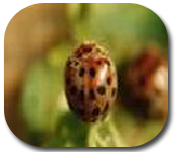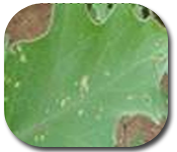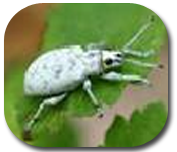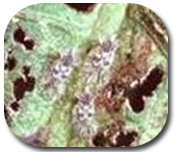TNAU Agritech Portal :: Crop Protection
 Shoot and fruit borer: Leucinodes orbonalis Shoot and fruit borer: Leucinodes orbonalis
| Symptoms of damage |
- Withering of terminal shoots/ dead hearts
- Bore holes on shoots and fruits plugged with excreta
- Shedding of flower buds
- Withering and drying of leaves
|
Withering
 |
Bore hole
 |
|
| Identification of pest |
- Eggs - Creamy white eggs
- Larva - pink in colour
- Pupa- greyish boat shaped cocoon
- Adult- a medium sized moth
- Forewings- having black and brown patches and dots on white colour
- Hind wings – opalescent with black dots
|
|
| Management |
- Remove the affected terminal shoot showing boreholes.
- Remove the affected fruits and destroy.
- Avoid continuous cropping of brinjal crop
- Grow the varieties with long and narrow fruits in endemic areas
- Install pheromone trap@12/ha
- Encourage the activity of larval parasitoids:
- Pristomerus testaceus
- Cremastus flavoorbitalis
- Avoid use of synthetic pyrethroids
- Avoid using insecticides at the time of fruit maturation and harvest
- Neem seed kernel extract (NSKE) 5 % or any one of the following chemicals starting from one month after planting at 15 days interval
|
| Insecticide |
Dose |
| Azadirachtin 1.0% EC (10000 ppm) |
3.0 ml/lit. |
| Azadirachtin 0.03 % WSP (300 ppm) |
5.0 g/lit. |
| Chlorpyrifos 20 % EC |
1.0 ml/lit. |
| Dimethoate 30 % EC |
7.0 ml/10 lit. |
| Emamectin benzoate 5 % SG |
4 g/10 lit. |
| Flubendiamide 20 WDG |
7.5 g/10 lit. |
| Phosalone 35 % EC |
1.5 ml/lit. |
| Quinalphos 25 % EC |
1.5 ml/lit. |
| Thiodicarb 75 % WP |
2.0 g/lit. |
| Thiometon 25 % EC |
1.0 ml/lit. |
| Trichlorofon 50 % EC |
1.0 ml/lit. |
| Triazophos 40 % EC |
2.5 ml/lit. |
|
Top
 Stem borer: Euzophera perticella Stem borer: Euzophera perticella
| Symptoms of damage |
- Top shoots of young plants droop and wither.
- Older plants become stunted.
- Fruit bearing is affected
|
| Identification of pest |
- Egg- Cream, scale-like
- Larva - Fully grown larva is creamy white
- Adult - Greyish brown,
- Forewings- with transverse line and
- Hind wings - white in colour
|
| Management |
- Collect and destroy the damaged and dead plants
- Light trap @ 1/ha to attract and kill adults
- Spray neem oil 2ml/lit
- Avoid using synthetic pyrethriods causing resurgence
|
Top
 Bud worm: Scrobipalpa blapsigona Bud worm: Scrobipalpa blapsigona
| Symptoms of damage |
- Shriveling and shedding of flower buds
|
| Identification of pest |
- Larvae - pale whitish with pink tinge
- Adult - small with fringed wings.
|
Adult
 |
|
Top
 Hadda / spotted beetle: H.vigintioito punctata Hadda / spotted beetle: H.vigintioito punctata
| Symptoms of damage |
- Scrapping of chlorophyll
- Skeletonization and drying of leaves
|
Skeletonized - Grub Damage
 |
Skeletonized - Adult damage
 |
|
| Identification of pest |
- Eggs- Cigar shaped, yellow in colour
- Grub: Yellowish bearing six rows of longitudinal spines.
- Pupa: Yellowish with spines on posterior part and anterior portion being devoid of spines.
- Adult: H. vigintioctopunctata : 14 spots on each elytra, deep red.
|
Adult
 |
Adult
 |
|
| Management |
- Collect damaged leaves with grubs and egg masses and destroy them
- Shake plants to dislodge grubs, pupae and adults and destroy
- Conserve natural enemies in brinjal ecosystem
- Spray any one of the insecticides
|
Top
 Ash weevils: Myllocerus subfasciatus, M. discolor, M. viridanus Ash weevils: Myllocerus subfasciatus, M. discolor, M. viridanus
| Symptoms of damage |
- Notching of leaf margins
- Grubs feed on roots - wilting of plants
|
V - shape notching
 |
V - shape notching
 |
|
| Identification of pest |
- Larva: grub - small and apodous
- Pupa: Pupates in soil in earthern cocoons
- Adult :
- M. maculosus: greenish white with dark lines on elytra
- M. subfasciatus: Brown
- M. discolor: Brown and white spots
- M. viridanus: Small light green weevil
|
Adult
 |
|
| Management |
- Collect and destroy adults
- Apply Neem cake @ 500 kg / ha at the time of last ploughing
- In endemic areas, apply carbofuran 3 G @ 15 kg/ ha – 15 days after planting
- Spray carbaryl 50 WP @ 3g + wettable su
|
Top
 Brown leaf hopper: Cestius phycitis Brown leaf hopper: Cestius phycitis
| Symptoms of damage |
- Reduction in size of leaves
- Shortened petioles,
- Excessive growth of branches general stunting of plants,
- Conversion of floral parts into leafy structures and
- Plants become bushy
- Fruiting is rare.
- Vector of little leaf of brinjal
|
| Identification of pest |
- Small light brown leaf hopper
|
| Management |
- Rogue out infected plants destroy them.
- Before transplantation dip the seedlings in 0.2% carbofuran 50 STD solution(control insect vectors).
- Spray with methyl parathion 0.5% or dimethoate 0.3%.
|
Top
 Lace wing bug: Urentius hystricellus Lace wing bug: Urentius hystricellus
| Symptoms of damage |
- Yellowing of leaves
- Affected leaves covered with exuviae and excreta
|
Affected leaves covered withexcreta
 |
Yellowing
 |
|
| Identification of pest |
- Egg -white nibble shaped eggs
- Nymph – yellowish white with prominent spines
- Adult
- Dorsal side - straw coloured
- Ventral side – black coloured
- Pronotum and forewings reticulated
|
| Management |
- Spray dimethoate 30 EC @ 1 lit / ha or methyl demeton 25 EC @ 1lit /ha
|
|

